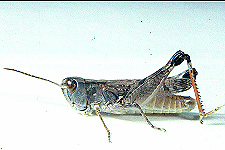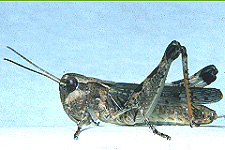Grasshoppers of Wyoming and the West
Entomology
Ageneotettix deorum (Scudder)
 |
 |
| Adult male | Adult female |
Common name - White-whiskers grasshopper (Hantsbarger, 1979) or Sand grasshopper (Pfadt, 1972).
Geographic distribution - British Columbia, Alberta, Saskatchewan and Manitoba (Canada); south to Mexico; east to Michigan, Indiana, Oklahoma and Texas (Brooks, 1958; Otte, 1981). In Colorado, the subspecies A. deorum deorum is widespread. The subspecies A. deorum curtipennis is found in southwestern Colorado (Alexander, 1941).
Habitat - sandy soil with sparse vegetation such as blowouts, abandoned fields and native grassland (Anderson, 1964; Blatchley, 1920; Brooks, 1958).
Food habits - feeds on grasses and sedges with no preference for any particular species. Some of the plants eaten are western wheatgrass, Sandberg bluegrass, sand dropseed, blue grama, threeawn, needleandthread, prairie sandreed grass, crested wheatgrass, cheatgrass brome, bluebunch wheatgrass and hairy grama. A. deorum also eats large amounts of dry plant debris (Anderson, 1964; Anderson and Wright, 1952; Campbell et al., 1974; Hewitt, 1977; Kumar et al., 1976; Mulkern et al., 1964; Mulkern et al., 1969; Ueckert and Hansen, 1971.)
Eggs - four eggs per pod. Average egg length, 5.3 mm; average diameter, 1.6 mm; color, pearly white. Pods are small and tough (Onsager and Mulkern, 1963; Shotwell, 1941).
Nymph - four or five instars (Ramsay, 1964).
Adult - medium size. General color is dull brown on top, light yellow on bottom. Face is slanted; vertex is rounded. Antennae are greyish-white to brown. Dorsal posterior margin of pronotum is rounded. Tegmina have a row of spots running the center length. The subspecies A. deorum deorum has tegmina at least half as long as the abdomen. A. deorum curtipennis has greatly abbreviated tegmina, about one-third as long as abdomen. Wings are clear. Hind femora have black knees and three dark spots on the upper surfaces. Hind tibiae are bright orange to red. Male length, 12 mm; female, 22 mm (Alexander. 1941; Blatchley, 1920; Brooks, 1958; Hantsbarger, 1979).
Oviposition - eggs are laid in the upper 1/4 in. of such open-packed ground as bare patches of hayfields, grainfields or native rangeland. The pods are deposited parallel to the soil surface and are sealed laterally (Onsager and Mulkern, 1963; Shotwell, 1941).
Seasonal history - adults are present from June to November in Arizona and from early July to mid-October in Montana and Wyoming (Ball et al., 1942; Newton et al., 1954).
Abundance and importance - very common on Colorado rangelands and can cause serious damage (Hantsbarger, 1979).
A. deorum fact sheet from the Field Guide to Common Western Grasshoppers
Next Species: Amphitornus coloradus
Previous Species: Aeropedellus clavatus
Biology of Common Colorado Grasshoppers List
Biology of Common Colorado Grasshoppers
Grasshoppers of Colorado Contents

